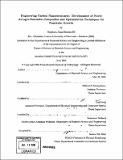Engineering carbon nanostructures : development of novel aerogel-nanotube composites and optimization techniques for nanotube growth
Author(s)
Steiner, Stephen Alan, III
DownloadFull printable version (20.75Mb)
Other Contributors
Massachusetts Institute of Technology. Dept. of Materials Science and Engineering.
Advisor
Mildred S. Dresselhaus and Jing Kong.
Terms of use
Metadata
Show full item recordAbstract
Carbon aerogels offer several unique advantages which make them ideal for evaluating a metal's ability to catalyze nanotube growth, including in situ carbothermic reduction of oxidized nanoparticles to their catalytic metallic phase as they form and production of a bulk quantity of nanoparticles which can be easily characterized. In this work, metal-doped carbon aerogels of seven transition metals were synthesized, characterized, and evaluated for their ability to catalyze growth of carbon nanotubes by thermal chemical vapor deposition (CVD). It was found that carbon aerogels doped with Fe, Rh, Re, Au, and Nb all catalyzed the formation of nanotubes in moderate to high yields, resulting in a direct growth of nanotubes on the exterior surfaces of aerogel monoliths. Ta was found to grow nanotubes only after thorough reduction of its oxides. Growth with W was inconclusive. CVD growth of nanotubes throughout the interior porosity of metal-doped carbon aerogels was also achieved by templating a network of interconnected macropores into the monoliths. Surface-based nanoparticles composed of rhenium, gold, and varying combinations of gold and rhenium were investigated for their ability to catalyze carbon nanotube growth. (cont.) Nanoparticles of these metals were nucleated onto silicon wafers from solutions of anhydrous ReCI5 and AuC13. After deposition, the nanoparticles were reduced under hydrogen for 10 min and then oxidized in air for 4 min. The samples were then processed by CVD employing hydrogen and ethanol-saturated Ar for 10 min. Nanoparticles deposited from metal chloride solutions with a 1:1 molar ratio of gold to rhenium or higher were found to result in high yields of single-walled nanotubes, where nanoparticles deposited from solutions with less than a 1:4 gold-to-rhenium ratio resulted in no nanotube growth. Lastly, a new low-pressure CVD system specialized for nanotube growth was developed. The objectives of the system are to provide a flexible architecture for developing new nanotube growth techniques and to lower the minimum temperature required for nanotube growth. The system features a separate sample heating plate for thermally activating nanoparticles and hot filament for carbon feedstock cracking. The system also features the ability to easily install or remove modules for electric field- and plasma-assisted growths.
Description
Thesis (S.M.)--Massachusetts Institute of Technology, Dept. of Materials Science and Engineering, 2006. Includes bibliographical references (leaves 219-233).
Date issued
2006Department
Massachusetts Institute of Technology. Department of Materials Science and EngineeringPublisher
Massachusetts Institute of Technology
Keywords
Materials Science and Engineering.